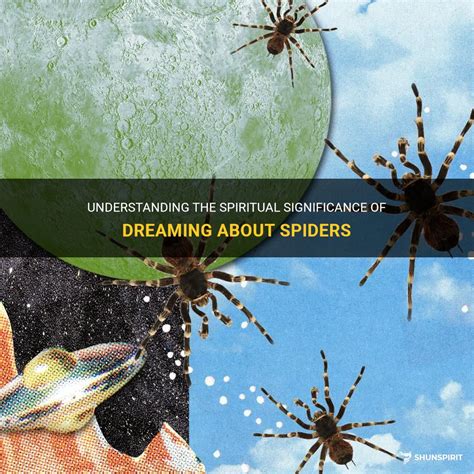Immerse yourself in a world where reality intertwines with the surreal, where curiosity dances with fear, and where the delicate threads of imagination weave enchanting tales. Join us on an exploration of the ethereal world inhabited by one of nature's most fascinating creatures – the agile and enigmatic spinner of webs, the tarantula.
Within the realms of the nocturnal, the tarantula exudes a mesmerizing aura, captivating the minds of those who dare to venture into its realm. Armed with a cunning and unwavering stealth, it gracefully traverses landscapes, leaving behind a trail of vibrant stories, each entangled within the intricate web of its existence.
Step into a dreamscape where the tarantula's footsteps are not mere movements but a transcendence into the unknown, where time stands still, and reality melts away like droplets of dew under the blanket of dawn. In this alternate reality, perception transforms, and the boundaries of possibility become fluid, as the tarantula becomes a symbol of untamed spirit. Its presence evokes a sense of simultaneous vulnerability and power, as if the mysterious weaver knows secrets that elude mortal comprehension.
Delve deep into the soul of this bewitching creature, seeking to unravel the threads of its nocturnal wanderings and uncover the mysteries that lie beneath its armored exoskeleton. As we embark on this journey through the enigmatic fantasies of a swift arachnid, prepare to be awed, unsettled, and inspired – for the dreams of a running tarantula bear witness to a world beyond our own.
The Intriguing Phenomenon of Agile Arachnids in Fantasies: Does It Hold Significance?

Within the realm of the human subconscious lies a peculiar spectacle that has captivated both scientists and dream enthusiasts alike. It involves the mesmerizing manifestation of nimble eight-legged creatures in one's reveries, a phenomenon often regarded as a thought-provoking enigma deserving of exploration. Engaging in a dance-like motion akin to swift locomotion, these agile arachnids, fondly known as the runners of the arachnid world, raise the curiosity of many in their nightly visions.
The Science Behind Dreaming and Its Connection to Arachnids
Dreaming is a fascinating phenomenon that occurs during our sleep, involving a series of complex neural processes. While dreams are often associated with surreal experiences, they also provide insights into our subconscious minds and play a crucial role in memory consolidation and emotional processing. This section will explore the scientific aspects of dreaming and its potential connection to tarantulas, a species of arachnids known for their intriguing behavior.
The study of dreaming, known as oneirology, involves investigating the brain activity and physiological changes that occur during sleep. Scientists have found that the brain enters different stages of sleep, each characterized by distinct patterns of brain waves. Rapid Eye Movement (REM) sleep, the stage associated with vivid dreaming, is particularly intriguing. During REM sleep, the brain becomes highly active, similar to its state during wakefulness. This suggests that dreaming is a result of the brain's continuous engagement, processing emotions, and consolidating memories.
| Stage of Sleep | Brain Wave Patterns | Dream Characteristics |
| NREM Sleep | Slow and synchronized brain waves | Less vivid and fragmented dreams |
| REM Sleep | Rapid and desynchronized brain waves | Vivid, emotional, and narrative dreams |
But what does this have to do with tarantulas? Interestingly, studies have suggested that our dreams may be influenced by our experiences and external stimuli. The theory of "threat simulation" posits that dreams serve as a way for our brains to navigate potentially dangerous situations in a safe, simulated environment. As tarantulas are often associated with fear and anxiety due to their appearance and venomous nature, it is possible that they may occasionally appear in our dreams as symbols of fear or danger.
Moreover, the connection between dreams and tarantulas can also be explored through the lens of symbolism and cultural associations. In various cultures, spiders, including tarantulas, have been imbued with symbolic meaning, representing themes such as creativity, mystery, and introspection. These cultural perceptions and personal associations with tarantulas may find their way into our dreams, shaping the narratives and imagery we experience during REM sleep.
While the science behind dreaming is still not fully understood, researchers continue to delve into the mysteries of this nocturnal phenomenon. By understanding the intricacies of dreaming and its potential connections to various aspects of our lives, including arachnids like tarantulas, we can gain further insights into the workings of the human mind and the fascinating world of dreams.
Decoding the Symbolic Meaning of Swift Spiders in One's Dreams

Within the realm of dreams, the subconscious mind often weaves intricate narratives using symbols, allegories, and metaphors. One such enigmatic symbol that frequently appears in dreams is the fast-moving arachnid known as the tarantula. Through careful interpretation, the symbolic significance of a sprinting tarantula can be unraveled, offering invaluable insights into the dreamer's psyche.
Exploring the Psychological Significance of Arachnid Reveries
Within the realm of subconscious nocturnal experiences, certain enigmatic visions featuring agile eight-legged creatures have captured the fascination of many. By delving into the psychological intricacies of these intriguing arachnid reveries, we can gain a deeper understanding of the profound implications they may hold.
When exploring the hidden depths of the human mind, it becomes evident that dreams possess a unique ability to unveil intricate aspects of our psyche. Through the lens of these nocturnal wanderings, we are offered a glimpse into the inner workings of our thoughts, emotions, and desires.
One peculiar manifestation that warrants exploration involves the presence of scuttling creatures known to possess both a fearsome reputation and an aura of mystery: tarantulas. Arising from the shadows of our subconscious, these formidable arachnids bring forth a symbolism that demands contemplation.
It is crucial to recognize that the interpretation of dreams is an inherently subjective endeavor, with individual experiences and personal contexts playing significant roles. However, when analyzing the potential psychological significance of tarantula dreams, several overarching themes readily emerge.
First and foremost, the appearance of tarantulas in dreams frequently elicits intense emotions, ranging from anxiety to fascination. These emotions serve as a reflection of our day-to-day experiences, suggesting that the arachnid symbolism resonates with deep-rooted aspects of our waking lives.
Moreover, tarantulas possess a unique duality in their representation, as they are both feared and revered in various cultures throughout history. This juxtaposition of fear and fascination suggests that tarantula dreams may symbolize a complex interplay between our fears and desires, urging us to confront and embrace the darker aspects of our existence.
Furthermore, the agility and speed displayed by tarantulas in dreams can serve as a metaphor for our own ability to navigate through life's challenges. They represent a call to action, prompting us to examine our own resilience, adaptability, and determination.
In conclusion, the investigation into the psychological significance of arachnid reveries offers a captivating avenue for exploring the intricate landscapes of our inner selves. Through dissecting the emotions, symbolism, and broader meanings associated with tarantula dreams, we embark on a journey towards self-discovery and personal growth.
Tarantulas in Popular Culture: From Nightmares to Inspirations

Tarantulas have long captivated the human imagination, leaving their indelible mark on various forms of popular culture. From the darkest corners of our nightmares to the finest threads of artistic inspiration, these arachnids have woven their way into our collective consciousness.
In literature and film, tarantulas are often portrayed as creatures of terror, symbols of fear and danger. Their hairy bodies and menacing fangs evoke a primal unease, their presence capable of inducing panic and terror. Countless horror stories and movies have exploited this fear, using tarantulas as nightmarish beings that haunt our dreams.
However, tarantulas have also found their place as symbols of resilience and power. Their ability to survive in harsh environments, their skillful maneuvering and agility, have inspired artists to harness these qualities to create characters of strength and determination. Tarantulas are transformed from mere monsters into fierce warriors, embodying the spirit of overcoming adversity.
Moreover, tarantulas have become cultural icons, influencing fashion, art, and even music. Their unique appearance, with patterns and colors that range from vibrant to subdued, has found its way onto fabrics and garments. Tattoos of tarantulas adorn the bodies of those seeking to express their affinity for these enigmatic creatures.
In the realm of music, tarantulas have inspired musicians to create haunting melodies and lyrics that capture the essence of these mysterious arachnids. The rhythms and melodies mimic the movements of a tarantula, invoking a sense of mystery and intrigue. From classical compositions to modern rock anthems, the influence of tarantulas in music is as diverse as their habitats.
As tarantulas continue to intrigue and captivate our imagination, their presence in popular culture persists. Whether they inspire fear or admiration, nightmares or dreams, it is undeniable that tarantulas have become a fascinating symbol in our collective consciousness, forever weaving their way into the fabric of our society.
FAQ
What is the article "Dreams of a Running Tarantula" about?
The article "Dreams of a Running Tarantula" explores the mysterious and fascinating world of tarantulas and their ability to dream.
Do tarantulas really dream?
According to recent studies, it has been suggested that tarantulas do have the capacity to dream. Researchers have observed certain behavioral patterns during their sleep cycles that resemble the characteristics of dreaming in other animals.
What are the possible reasons behind tarantulas' ability to dream?
The exact reasons behind tarantulas' ability to dream are not fully understood. However, it is hypothesized that dreaming may serve important functions such as memory consolidation, learning, and emotional processing, just like in other animals.
How are tarantulas' dreams different from those of humans?
Tarantulas' dreams are likely to be very different from those of humans due to the distinct neural structures and behaviors of these creatures. While humans often experience vivid and complex dreams, tarantulas' dreams may involve simpler sensory experiences or instinctual behaviors that are relevant to their survival.
What implications do the findings about tarantulas dreaming have?
The findings about tarantulas dreaming have significant implications for our understanding of animal cognition and the evolution of dreaming. It provides insights into the presence of certain cognitive abilities in seemingly "primitive" organisms, highlighting the complexity and diversity of life on Earth.
What is "Dreams of a Running Tarantula" about?
"Dreams of a Running Tarantula" is an article that explores the symbolism and meaning behind dreams featuring a running tarantula.
Are tarantulas dangerous?
Tarantulas are generally not dangerous to humans. While their venom can be potent and cause some discomfort, their bites are rarely fatal to humans and are comparable to a bee sting.



